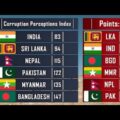Bangladesh and Pakistan the two south Asian countries, which together was a single nation before 1971, previously known as East Pakistan and West Pakistan. In 1971 Pakistan was 70% richer than Bangladesh, but now the tables have turned, today Bangladesh is 45% richer than Pakistan.
You see, after breaking up in 1971, both the countries were in a bad state. But in comparison, Pakistan had more resources than Bangladesh. In fact, Pakistan was better off than many post-colonial states in terms of its economy, human development, infrastructure, and industrialization progress till the mid-1980s. At the same time, Bangladesh has to start from scratch and build the political and economic structure to stand as a country. So it was a very slow start for them.
But today when you look at these two nations, you will see a very different picture.
On one hand, Bangladesh’s remarkable performance during the past decades transformed the country’s economy. Despite problems like political instability, poor infrastructure, corruption, and insufficient power supplies Bangladesh’s economy has grown 5.8% per year since 1996. In fact during the 2008 financial crisis Bangladesh’s growth was resilient.
On the other hand, when you look at Pakistan in 2020 their public debt went past 87% of the GDP, and the country’s total external debt and liabilities rose to $113.8 billion in the fiscal year 2020. Today the country spends 1/3rd of its federal budget on repayments of these loans.
Today the exports of Bangladesh are double than Pakistan, their currency, which is the Bangladeshi taka, is also nearly double than that of Pakistan’s rupee. And the foreign exchange reserves held by Bangladesh are more than $41 billion which is again double than Pakistan’s $20 billion forex reserves. Now what Pakistan has more than double of that of Bangladesh is also the debt to GDP ratio. Bangladesh has a debt to GDP ratio of around 35%, whereas Pakistan’s is 80%. And having a high debt to GDP ratio for any developing country is not a good thing.
Now the question here is How did a country like Bangladesh which during its formation was predicted to fail and return to Pakistan, achieved soo much more than its cousin.
Well, one of the main reasons is Bangladesh’s industry. Bangladesh has become the 2nd largest manufacturer of the ready-made garment. It is the main item of export which accounts for 84.21% of total exports of the nation. This has happened because Bangladesh has a massive labor force, it is the 8th largest in the world. And Bangladesh is capitalizing upon low skilled labor force, in labor incentive export industries. It’s the same strategy that many of the other Asian nations used for their industrial sector specifically in manufacturing. Today the garment industry in the country provides direct employment for four million workers. And indirect employment to nearly 10 million people. And it is estimated that 80% of workers in this industry are women, this has a good impact on women empowerment in the country as well. Also, countries’ garment industries benefited from custom-free access to many western countries. As you know Bangladesh is on the list of least developed countries and due to this many rich countries in the west removed the export duties to help the developing countries. And it makes made in Bangladesh garments more competitive in the world.
Pakistan also tried to be an export giant in the garment industry. Despite being a cotton growing country it has failed to increase its exports of garments and textile products beyond $10 billion. In fact Pakistan is now importing cotton. Due to a lack of innovation and policies, the country is unable capitalize upon its agricultural resources, particularly cotton, and increase its exports of textiles and other products.
Another reason is, Bangladesh primarily focuses on human development and economic growth. As a result, Bangladesh is ahead of Pakistan in areas like women empowerment, passport index, literacy ratio, and also micro-credit financing. You see, where Bangladesh spending are mainly focused on human development aspects like education and healthcare, Pakistan spends a big chunk of its budget on the military, leaving health and education far behind.
Now we need to understand, for Pakistan, the average age of its citizens is just 22 years. This gives Pakistan an advantage in the demographic dividend. But this will be only advantageous if Pakistan prioritizes human development. When people will get good education, healthcare and other things, the productivity will eventually increase.
Today Pakistan isn’t exactly failed but we cannot deny that it is on the verge of failing. So they need to understand looking at Bangladesh development model, what is really required for social and economic development.
#bangladeshvspakistan #pakistaneconomy








